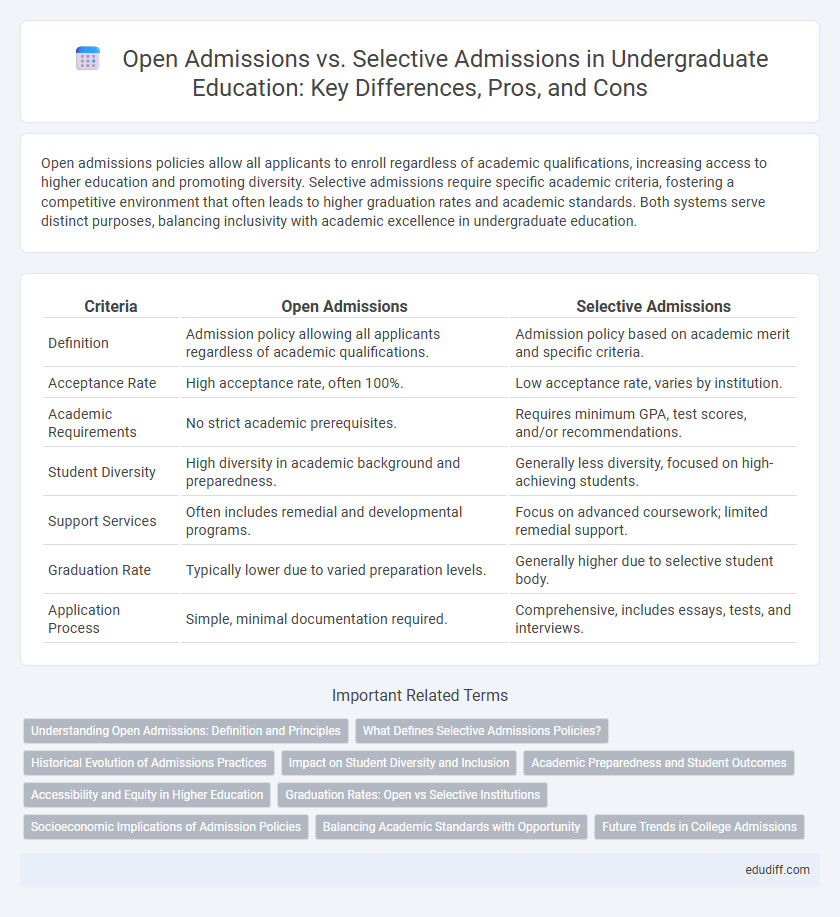Open admissions policies allow all applicants to enroll regardless of academic qualifications, increasing access to higher education and promoting diversity. Selective admissions require specific academic criteria, fostering a competitive environment that often leads to higher graduation rates and academic standards. Both systems serve distinct purposes, balancing inclusivity with academic excellence in undergraduate education.
Table of Comparison
| Criteria | Open Admissions | Selective Admissions |
|---|---|---|
| Definition | Admission policy allowing all applicants regardless of academic qualifications. | Admission policy based on academic merit and specific criteria. |
| Acceptance Rate | High acceptance rate, often 100%. | Low acceptance rate, varies by institution. |
| Academic Requirements | No strict academic prerequisites. | Requires minimum GPA, test scores, and/or recommendations. |
| Student Diversity | High diversity in academic background and preparedness. | Generally less diversity, focused on high-achieving students. |
| Support Services | Often includes remedial and developmental programs. | Focus on advanced coursework; limited remedial support. |
| Graduation Rate | Typically lower due to varied preparation levels. | Generally higher due to selective student body. |
| Application Process | Simple, minimal documentation required. | Comprehensive, includes essays, tests, and interviews. |
Understanding Open Admissions: Definition and Principles
Open admissions policies allow all applicants meeting basic educational requirements to enroll in undergraduate programs, promoting inclusivity and broader access to higher education. These principles emphasize equal opportunity, minimal entry barriers, and support services to help diverse student populations succeed. By prioritizing accessibility over selectivity, open admissions institutions aim to democratize education and address social equity.
What Defines Selective Admissions Policies?
Selective admissions policies prioritize academic excellence by evaluating applicants based on GPA, standardized test scores, extracurricular achievements, and personal statements. These institutions set competitive criteria to admit a limited number of students who demonstrate the highest potential for success and contribution to the campus community. The process often includes holistic reviews to identify well-rounded candidates beyond quantitative metrics.
Historical Evolution of Admissions Practices
Open admissions, which emerged in the 1960s, aimed to democratize higher education by allowing all high school graduates to enroll without stringent entry requirements, reflecting a shift towards educational accessibility and equity. Selective admissions, with roots dating back to early 20th-century elite institutions, emphasize academic achievement, standardized testing, and extracurricular excellence to maintain institutional prestige and competitive student bodies. Over time, the evolution of admissions practices has balanced expanding access through open policies with maintaining quality and reputation through selective criteria, adapting to changing social and economic demands.
Impact on Student Diversity and Inclusion
Open admissions policies significantly increase student diversity by reducing barriers to entry and providing opportunities for underrepresented groups to access higher education. Selective admissions tend to prioritize academic metrics, which can limit inclusion by disproportionately affecting applicants from marginalized backgrounds with less access to preparatory resources. Institutions with open admissions often experience higher enrollment rates of minority and first-generation college students, fostering a more inclusive campus environment.
Academic Preparedness and Student Outcomes
Open admissions policies typically increase access by admitting students regardless of academic credentials, leading to a diverse student body with varying levels of academic preparedness. Selective admissions prioritize applicants with stronger prior academic performance, often resulting in higher retention rates and better graduation outcomes. Research shows that students admitted under selective criteria generally experience more favorable academic success and post-graduate opportunities compared to those admitted through open enrollment.
Accessibility and Equity in Higher Education
Open admissions policies enhance accessibility by allowing a broader range of students, including those from underrepresented or disadvantaged backgrounds, to enroll without stringent academic prerequisites. Selective admissions, while promoting academic excellence, often create barriers that can limit equity by favoring applicants from more privileged educational environments. Balancing these approaches is crucial for institutions striving to expand higher education access while maintaining quality standards.
Graduation Rates: Open vs Selective Institutions
Graduation rates at selective institutions typically surpass those at open admissions colleges, reflecting more rigorous admission standards and tailored support systems that enhance student retention. Open admissions institutions often enroll a more diverse and academically varied student body, which can contribute to lower overall graduation rates due to differing preparedness levels. Data from the National Center for Education Statistics highlights that selective institutions boast graduation rates around 70-80%, while open admissions colleges average closer to 30-50%.
Socioeconomic Implications of Admission Policies
Open admissions policies increase access to higher education for low-income and underrepresented students by minimizing barriers such as standardized test scores and GPA thresholds. Selective admissions often correlate with higher tuition costs and limited spaces, disproportionately favoring students from affluent backgrounds with greater access to preparatory resources. The socioeconomic implications of these policies affect diversity, social mobility, and equity in educational outcomes across the undergraduate population.
Balancing Academic Standards with Opportunity
Open admissions policies increase access by allowing all applicants to enroll regardless of academic background, promoting educational opportunity and diversity. Selective admissions emphasize academic standards by accepting students based on GPA, test scores, and other criteria, ensuring a focused and prepared student body. Balancing these approaches involves creating pathways for underprepared students while maintaining rigorous standards to uphold educational quality and institutional reputation.
Future Trends in College Admissions
Future trends in college admissions highlight a growing shift towards open admissions policies to promote increased accessibility and diversity among undergraduate populations. Data indicates that institutions adopting open admissions experience higher enrollment rates from underrepresented groups, aligning with evolving societal demands for equity in education. Selective admissions may increasingly integrate holistic approaches, utilizing predictive analytics and AI to assess applicants' potential beyond standardized test scores and GPA.
Open Admissions vs Selective Admissions Infographic

 edudiff.com
edudiff.com